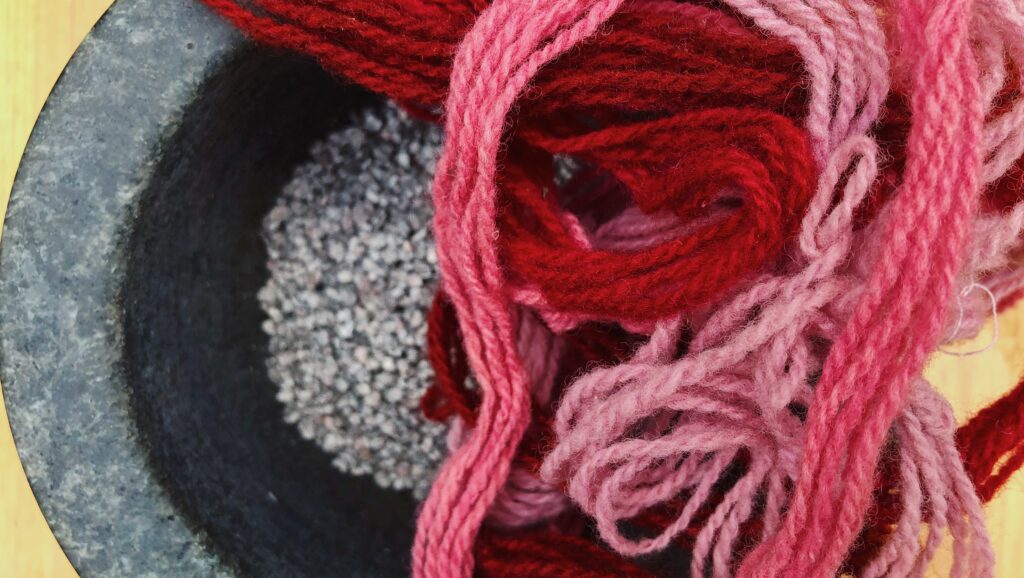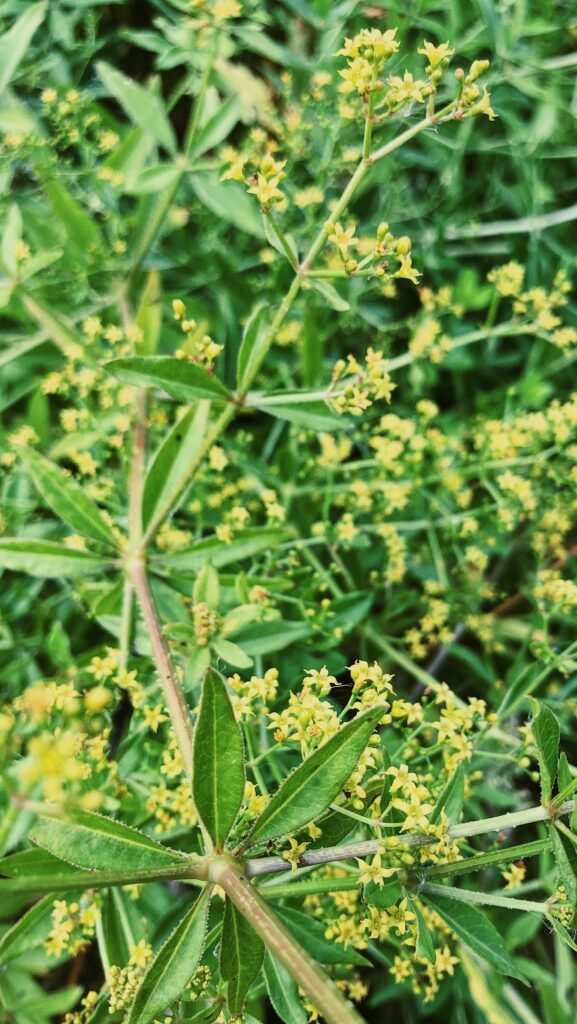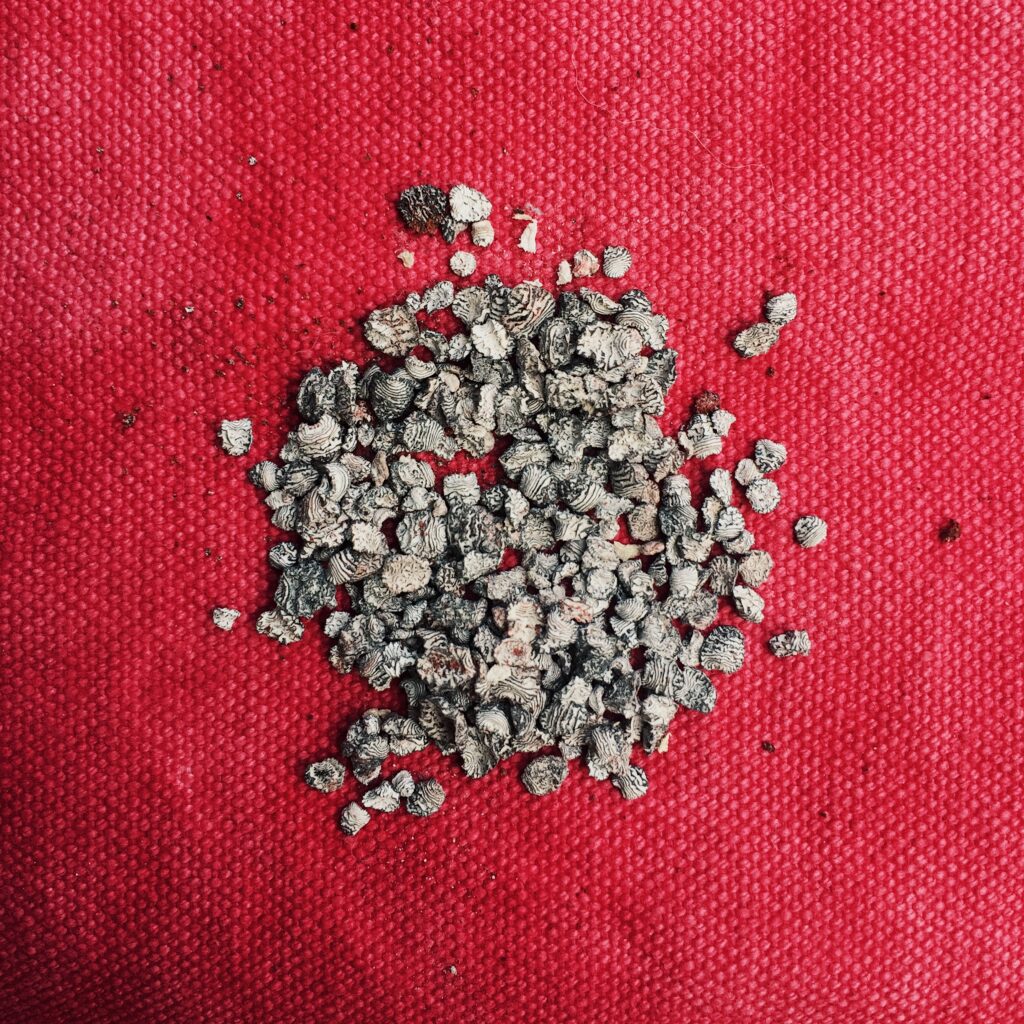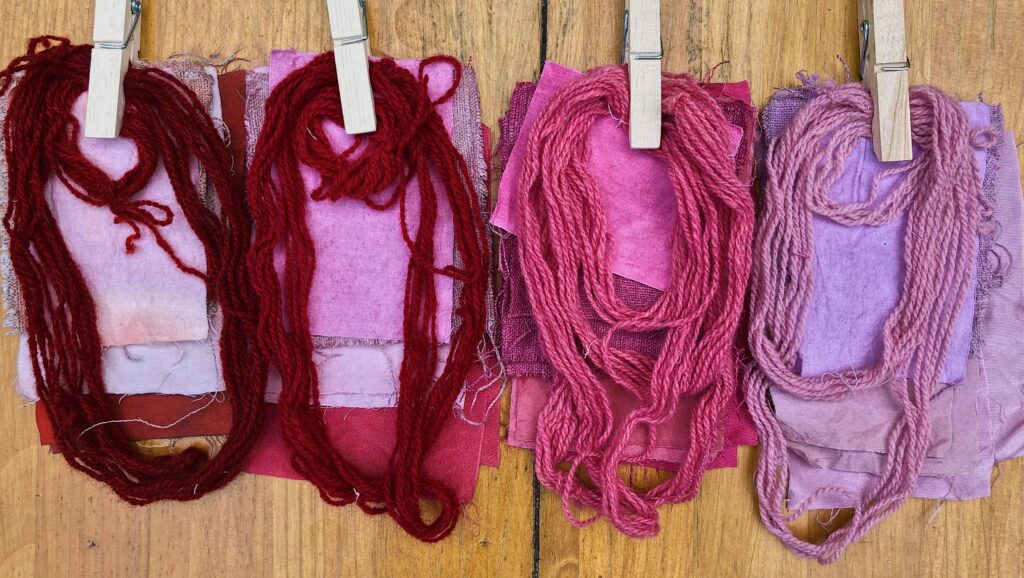Creating with natural red dye makes me feel free, passionate and alive.
There’s just something about the colour red that makes me feel good. It’s strong, bold and always makes a statement no matter what I’m creating with it.
It’s also a versatile colour and can be blended with darker brown shades, maroons and mahoganys or even more neutral colours (which I also love) to offer a little variation.
There is such a range of different shades when it comes to dyeing with cochineal to make natural red dye – the possibilities are endless!
Let’s explore the ins and outs of dyeing with cochineal, to harness the power of nature and red.

Natural red fabric dye can come from many brilliant sources
Like all natural dyes, there are a number of different sources and materials that can be used to create a bold shade of red and many others in between.
Creating a strong, bold red is possible using the most natural of sources, such as insects and plants, however I’ll dive into the best historical sources for creating red.
Madder
Using madder (Rubia tinctoria) as a natural dyestuff is great for creating different shades of red ranging from deep reds, pale pinks to terracotta browns and even purples. Madder is a herbaceous perennial plant found in temperate areas around the world throughout the Mediterranean region, Asia, Africa, and the Americas. Madder roots is what you would typically use for dyeing.
Cloth dyed with madder has been found in ancient mummies and goes all the way back to the earliest historical times. It was introduced into the world as a natural dyeing source by the Egyptians, Greeks and Romans.

Cochineal
Using cochineal (Dactylopius coccus) to create natural red fabric dye is still known to this day as one of the most prominent natural dye discoveries. (And it’s my favourite source of red dye due to the colour uptake and historical fun facts).
The cochineal is a little parasitic insect that grows and spends all its life in the pads of the nopal or prickly pear cactus. It is native to Mexico, Central America and certain regions of South America. Following its discovery it quickly became used in high volumes of fabric production in South America and Europe (especially Spain).
Way back in time in Mexico with the Aztecs, cochineal was a way to pay tribute to the dominating civilisations. It was used for painting, dyeing feathers, furs from hares, stones and wood, it was also used by women as a cosmetic: they used it to paint their teeth red.
So in essence, the relationship between Nature and fashion has an interesting history where at least my ancestors learned how to play with natural resources to bring colour to their traditions, celebrations, clothes and more, which I find fascinating.
And now diving into why I love cochineal for natural dyeing, it works brilliantly on protein fibres, such as wool, silk, mohair or alpaca, however you won’t have as much luck with cellulose fibres such as linen, cotton, bamboo or hemp. You’ll aslo achieve different shades of reddish/purple, bright reds, magentas and pale pink.
You might not be able to find it in the wild, but most natural dye suppliers sell it.
If you want to dye with cochineal make sure you scour and mordant your textiles for long-lasting results. I’ll go over the additional steps below!

Preparation: How to dye with cochineal to make natural red dye
You will need:
- Fibres that you’ll dye
- Kitchen scales
- A dedicated dye pot
- Dedicated wooden spoon, tongs or a stick
- Sieve or funnel
- Coffee filters
- Pestle and mortar
- Jars or containers
- Face mask
- Cochineal
- Cream of tartar
- Source of heat
Dyeing with cochineal: step by step
Extraction process:
- Weight the cochineal. Use 25% of the weight of fibre. So if you’re dyeing 100g of fibre, you’ll need 25g of cochineal.
- The best way to extract the most colour from cochineal is to grind it as finely as possible so that you can extract the most colour without having to make various extractions.
USE A FACE MASK FOR THIS! It’s not good for your lungs to inhale fine powders of any kind.
- Once it’s finely ground and you can’t see any more grey or white parts, put it in your pot.
- Use enough water to cover the cochineal. I recommend using the least possible amount of water so that the filtration process doesn’t take so long.
- Bring to a low boil for at least half an hour.
- Let the dye cool down and use a coffee filter to filter out the ground cochineal. You can use a sieve or funnel to keep the coffee filter in place. It’s very important to filter out the ground cochineal and keep only the liquid because otherwise the powder can stain your fibres during the dyeing process. You could also use an unmordanted muslin pouch like a tea bag to put your ground cochineal inside. This way, there’s no need to filter it out.
- Save the ground up cochineal that stays in the coffee filter because you can use it again to make a second and even a third extraction. Cochineal is a very potent dyestuff!
Dyeing process:
- Soak your fibres for at least half an hour before dyeing.
- Add your filtered liquid dye to your pot, add 25% of the weight of fibre in cream of tartar (e.g. if you’re dyeing 100g of fibre, add 25g of cream of tartar) and enough water to make sure your fibres are well- covered and can move around freely.
- Add your wet fibres to the pot and bring it to a low simmer.
- Stir your fibres constantly, so the dye uptake is uniform.
- Once an hour has passed since the water reached a low simmer, turn off the heat and let the fibres cool in the pot. If you can leave them soaking all night with the lid on, it’s much better.
- Rinse out your fibres under running water until it runs clear and put to dry away from the sun.
- You can reuse your dye bath until there’s no more colour left. Cochineal is a very generous dyestuff, so you’ll be able to make a second and possibly even more subsequent dye baths. Remember that the colour will get lighter with each dye bath.
- Once your bath has no more colour, you can pour it straight into the soil or down the drain.
Dyeing natural fibres is like riding a bike – once you learn it right the first time, you’re on a roll.
Red is a beautiful colour to extract from cochineal, and the good news is that it isn’t the only natural dyeing goodness that can come from dyeing with cochineal.
Learn to create a wide variety of colours such as pink, magenta, purple and orange from cochineal by playing with various pH modifiers, as well as how to use other dyestuffs for a full spectrum of colour.
Although learning natural dyeing can be self-taught, there are many complexities to natural dyeing and having a seasoned expert to guide the way can make the learning process a whole lot more enjoyable.
The Living Colour with the Five Elements online natural dyeing workshop is a step-by-step framework where you’ll learn how to apply colour to natural fibres in a safe, long-lasting and sustainable way, using plants, insects and clay.
You’ll also learn more about the benefits of this practice for humans, our non-human siblings and the planet
So what are you waiting for? I hope to see you there!

